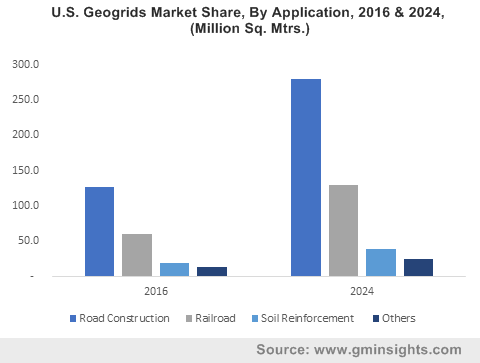Home > Construction > Construction Materials > Structural Materials > Geosynthetics Market
Geosynthetics Market Size
- Report ID: GMI2254
- Published Date: Dec 2017
- Report Format: PDF
Geosynthetics Market Size
Geosynthetics Market size was over USD 7.5 billion in 2016 and industry expects consumption at over 15 billion square meters by 2024.

Significant growth in construction activities along with increasing applications in filtration, separation and erosion control shall stimulate the geosynthetics market growth. Increasing demand for durable materials that offer superior mechanical protection and wastewater treatment has further created several opportunities for product demand. Geosynthetic materials have emerged as a new dimension in the construction of roads, drainage systems and railroads owing to their high tensile strength and ability to improve subsurface drainage. Building construction investments in Japan amounted over USD 280 billion in 2016 which shall a positive impact on the market growth. Increasing demand for sustainable solutions in wastewater treatment pertaining to rising environmental concerns may augment the market share.
These materials are utilized in several stages of construction activities to strengthen infrastructure, control evaporation and limit erosion to promote longevity and safety of structures. These high quality solutions significantly reduce carbon emissions owing to their eco-friendly nature, offer exceptional bearing capacity and evenly distribute load forces by creating a stable foundation. Carbon emissions from building & construction works in UK amounted over 3.3 million metric tons in 2016. This increasing rate has urged manufacturers to develop and use environment friendly alternatives which will further boost the geosynthetics market growth.
| Report Attribute | Details |
|---|---|
| Base Year: | 2016 |
| Geosynthetics Market Size in 2016: | 7.5 Billion (USD) |
| Forecast Period: | 2017 to 2024 |
| 2024 Value Projection: | 12 Billion (USD) |
| Historical Data for: | 2013 to 2016 |
| No. of Pages: | 600 |
| Tables, Charts & Figures: | 1,229 |
| Segments covered: | Product and Region |
Geosynthetic are susceptible to blockage by various materials such as plant roots, petrochemical compounds and sediments. Once exposed for a longer time period, these products are susceptible to being ripped which reduces the product performance. In addition, installation of the product for various applications such as soil reinforcement and construction requires experienced contractor in order to ensure soil stabilization and erosion protection which increases the overall installation cost, thereby hampering the market growth. However, superior advantages of the product over metal, steel and other construction materials will stimulate the market size.
